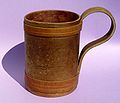Drinking vessel
Drinking vessels are vessels that are used to make drinks ready for consumption .
One can differentiate drinking vessels according to their material, their shape and their content as well as their purpose.
material
The oldest drinking vessels in human history were certainly the hands, followed by the first drinking vessels made of plant material such as leaves, wood or plant bowls (e.g. pumpkin ), but also animal material such as B. shells or leather . The drinking horn , which is made of horn and is considered the classic drinking vessel of Germanic peoples, was used as early as the Bronze Age .
Until modern times, drinking cups were mostly made of ceramics (e.g. porcelain , faience , earthenware ) or metal (e.g. gold , silver , pewter , tin ). Drinking vessels made of glass ( drinking glasses ) were already widespread in Roman times . Since the 20th century, plastic or cardboard ( paper cups ) has been the usual material for drinking vessels .
shape
Essentially, there are two open form variants, namely open drinking vessels without handles such as drinking glass, cup , bowl and cup , as well as open drinking vessels with handles, as pitcher and cup , also called Häferl or mug in Austria and southern Germany. In addition to the open drinking vessels, there are also closed drinking vessels, mostly for transport and use on the go, such as the drinking bottle , the beverage can or (in the military) the canteen . A special shape that stands between open and closed drinking vessels is the Spanish porrón , a glass or clay container with a filling opening at the top and a funnel-shaped drinking tube with a narrow spout on the side.
content
In addition to water, other drinks are historically documented very early: Wine and beer were already popular with the Sumerians and in ancient Egypt . Wine goblets such as Kylix , Phiale , Skyphos and Kantharos are known from ancient Greece . Today there are a variety of wine glasses for wine , including special red wine and white wine glasses . Regional such wine glasses are z. B. called Dubbeglas (in the Palatinate), Pfiffche or Viertele , where Pfiffche and Viertele actually refer to the unit of measurement for the wine rather than the wine glass. A special variant of the wine glass is the Römer , a traditional drinking vessel developed in the 16th century from the forest glass and widely used in Central Europe.
Greek kylix of the Euergides Painter
A large number of drinking vessels made of clay, glass or silver have also been used for beer since Roman times. Today, different drinking vessels are used in Germany depending on the type of beer and region. For wheat beer z. B. wheat beer glasses, specially shaped tall, slim glasses, established. Other traditional beer glasses that can be found in Germany are the tankard or Seidel, the Maßkrug and the beer boot .
Specially shaped drinking vessels are also used for other alcoholic beverages: For sparkling wine, there is the champagne glass, either in the form of a tall glass in the shape of a tulip or flute, usually with a short stem, or as a champagne bowl with a flat bowl with a slim stem. For spirits there are z. B. the tumbler or cocktail glass .
Drinking glasses are common for water and juice .
After tea, coffee and chocolate were spread as new drinks in Europe from the 16th century, new, special drinking vessels emerged in Europe. The previously common metal cups turned out to be unsuitable for hot beverages, as the heat conduction easily burned your mouth and fingers. Therefore, drinking bowls made of porcelain were imported from China, later on the coffee cups , tea cups and tea glasses common in Europe today developed from them .
purpose
With some drinking vessels, a distinction is also made according to their purpose, e.g. B. whether they are used in religious or profane contexts. For example, the different cup from the cup by the fact that the cup is a mundane vessel while the cup in religious rituals (z. B. in church) is used.
See also
literature
- Fritz fighter: mug tankards trophies . Stauffacher-Verlag, Zurich 1977, ISBN 3-287-00084-5 .
- Ceramic Museum Westerwald, Uwe Chr. Finke ( edit .): Drain me and pour me: drinking vessels from five millennia . Rastal, Höhr-Grenzhausen 1991, ISBN 3-921548-47-0 .
- City of Paderborn (Hrsg.): Dispensing and drinking vessels from four millennia . Paderborn 1996.
Web links
Individual evidence
- ^ Fritz fighters: Mug tankards trophies . Stauffacher-Verlag, Zurich 1977, ISBN 3-287-00084-5 , p. 48 .
- ^ Fritz fighters: Mug tankards trophies . Stauffacher-Verlag, Zurich 1977, ISBN 3-287-00084-5 , p. 33 .
- ^ City of Paderborn (Ed.): Dispensing and drinking vessels from four millennia . Paderborn 1996, p. 8 .
- ^ City of Paderborn (Ed.): Dispensing and drinking vessels from four millennia . Paderborn 1996, p. 10 .











